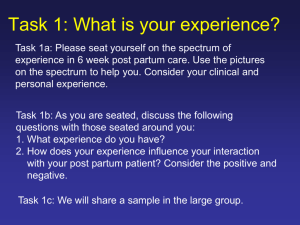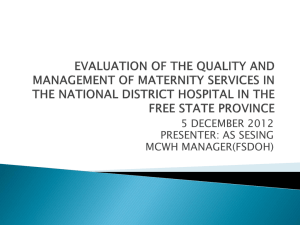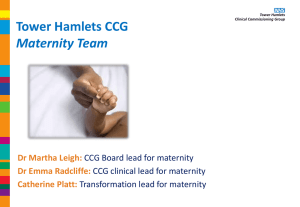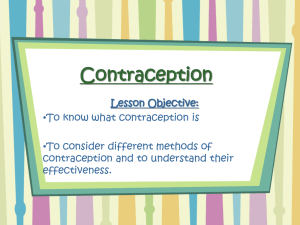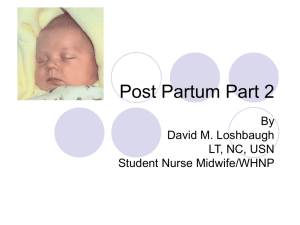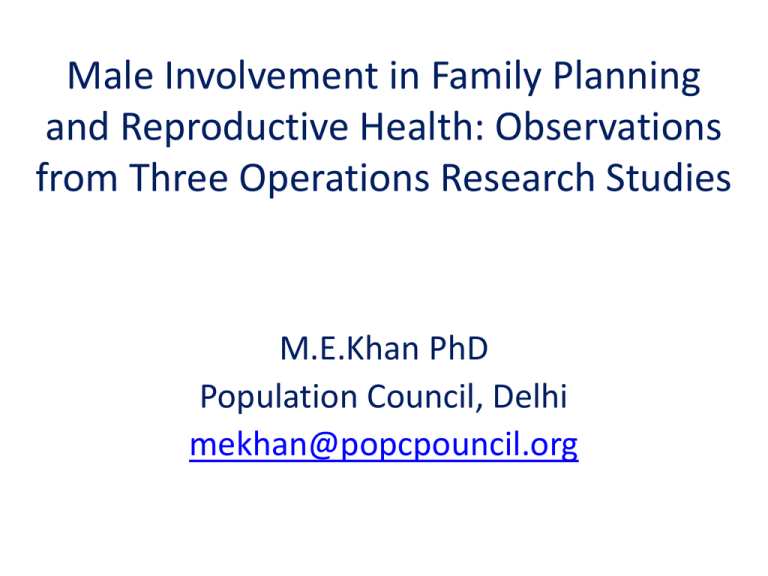
Male Involvement in Family Planning
and Reproductive Health: Observations
from Three Operations Research Studies
M.E.Khan PhD
Population Council, Delhi
mekhan@popcpouncil.org
Three OR studies
• Men in maternity care
men as health care taker of partner
• Men in promoting post partum contraception
Men in family planning
• Provision of RH services from women centric clinic
Men as client , gender equity to services
Broad Questions Addressed
• Feasibility
Can it be done?
• Operational details How to implement?
• Sustainability
Can it be integrated with
exiting health system?
• Affordability
At what cost?
• Creating condition for scaling up
Men in Maternity care
• Project goal:
To develop a cost-effective and sustainable maternity
care program which incorporates male partners and aims
to improve reproductive health and pregnancy outcomes
• Coverage:
Implemented in MCH clinics of Delhi managed by ESIC
Initially in 6 clinics; scaled up in all 35 clinics in Delhi
• Study Design:
Quasi experimental- control with pre-post design
Men in Maternity care: Interventions
• Couple counseling: birth plans, emergency
obstetric care, breastfeeding, family planning
• Same sex individual or group counseling on
STIs, condom demonstration
• Universal on-site syphilis screening
• Syndromic management of male urethral
discharge, male and female genital ulcers
• Promoting utilization post partum services
Men in Maternity Care: Results
• More men came with their wives (91% Vs 64%),
received any counseling (52 %Vs 21%), joint
counseling (26% Vs 2 %), more received
information on BF, immunization
• Increased knowledge of danger sine, pregnancy
preparedness, STI, Dual protection of condom, …
• Increased H-W communication
• Increased use of FP ( 51%V41%) and condom
(36V26 %)
Promoting Post partum Contraception
A BCC Intervention
• Project Goal:
To develop a BCC campaign model to to
promote PPC among zero and first parity
women using
• Coverage: 24 villages now scaled up to 48
villages.
• Study Design: Quasi- experimental- control,
pre-post design
• 600 pregnant women were registered and
followed up till 9 month post partum
Promoting Post partum Contraception:
Interventions
Educational campaign by Community level
workers(CHW) – ASHA, AWW, ANM
Audience specific messages reinforcing their perceived
needs for spacing. Husbands were focused target
Alignment and reinforcement of messages through
different channels
CTU and reorientation of CHW for strengthening
counseling skills and use of counseling aids
Supportive supervision and regular review meetings
Joint effort to implement intervention by two
Ministries—optimum use of existing resources
Promoting Postpartum Contraception:
Results
• Significant increase in correct knowledge of all FP
methods (LAM 74 Vs 1%) IUD (68 Vs 18)
• 4-month follow up:22% against non were using LAM
• 68 % LAM users switched over modern FP methods
• H-W communication on FP / STI increase significantly
• 9-month follow up: 63% against 32% were using any
FP method
Integration of RH services for men in
HFWC, Bangladesh
• Project Goal: To test feasibility of integrating men
RH services (STI , FP ) in Health and Family
Welfare Centers(HFWC) – a women centered
clinic . HFWC covers 30,000-50,000 population
• Coverage: 12 HFWC – 8 experimental and 4
control . Scaled up in 40 HFWC . Third stage MOH
recommended for scaling up in100 HFWC
• Study design: Quasi-experimental –control design
Integration of RH services for men in
HFWC: Intervention
• Orientation of the staff in syndromic
management of RTI and STI –theoretical as
well as practical
• Introduction of Systematic screening tool to
identify unmet RH needs
• Educational campaign using different channels
of communication
Integration of RH services for men in
HFWC: Results
• Significant increase in knowledge of workers in Exp.
group about signs and symptom of different STI. No
change in Control group
• Demonstrated correct knowledge of using flow graph for
of the syndromic management of RTI
• Large number of men started availing services from of
HFWC – mostly for general heath problems
• Number of women clients using HFWC also increased
significantly
• Utilization of HFWC increased by more than 60 percent
Conclusions
• Younger generation is changing fast and men are willing
to be involved in maternity care and supporting PPC
• Lack knowledge and generally are neglected by health
and FW workers
• Men involvement leads to positive RH/FP/ MCH results
• Men and women could be served from same clinic
• With minor modification in existing health system, men
involvement could be achieved
• Most required changes are financially sustainable
• Long term TA for HS capacity building is critical
• In resource constrained country, partnering with other
donors could make significant difference


